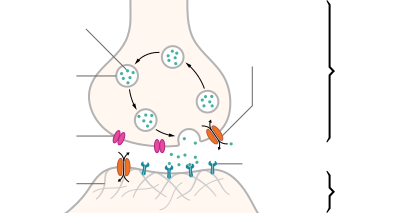Synapse
In the nervous system, a synapse is a structure that permits a neuron to pass an electrical or chemical signal to another cell (neural or otherwise). Santiago Ramón y Cajal proposed that neurons are not continuous throughout the body, yet still communicate with each other, an idea known as the neuron doctrine.[1]. The word "synapse" comes from "synaptein", which Sir Charles Scott Sherrington and colleagues coined from the Greek "syn-" ("together") and "haptein" ("to clasp").
Synapses are essential to neuronal function: neurons are cells that are specialized to pass signals to individual target cells, and synapses are the means by which they do so. At a synapse, the plasma membrane of the signal-passing neuron (the presynaptic neuron) comes into close apposition with the membrane of the target (postsynaptic) cell. Both the presynaptic and postsynaptic sites contain extensive arrays of molecular machinery that link the two membranes together and carry out the signaling process. In many synapses, the presynaptic part is located on an axon, but some presynaptic sites are located on a dendrite or soma. Astrocytes also exchange information with the synaptic neurons, responding to synaptic activity and, in turn, regulating synaptic transmission.[2]
There are two fundamentally different types of synapses:
- In a chemical synapse, the presynaptic neuron releases a chemical called a neurotransmitter that binds to receptors located in the postsynaptic cell, usually embedded in the plasma membrane. The neurotransmitter may initiate an electrical response or a secondary messenger pathway that may either excite or inhibit the postsynaptic neuron.
- In an electrical synapse, the presynaptic and postsynaptic cell membranes are connected by special channels called gap junctions that are capable of passing electric current, causing voltage changes in the presynaptic cell to induce voltage changes in the postsynaptic cell. The main advantage of an electrical synapse is the rapid transfer of signals from one cell to the next. [3]
Synaptic communication is distinct from ephaptic coupling, in which communication between neurons occurs via indirect electric fields.
Additional images
-
A diagram of a typical central nervous system synapse.
-
The synapse and synaptic vesicle cycle
-
Illustration of the major elements in chemical synaptic transmission.
References
- ^ Elias, L. J, & Saucier, D. M. (2005). Neuropsychology: Clinical and Experimental Foundations. Boston: Pearson
- ^ Tripartite synapses: astrocytes process and control synaptic information, Trends in Neurosciences, Volume 32, Issue 8, 421–431, 27 July 2009
- ^ Silverthorn, Dee Unglaub, William C. Ober, and Claire W. Garrison. Human Physiology, An Integrated Approach. 4th ed. San Francisco: Benjamin-Cummings Pub Co, 2007. 271. ISBN 978-0-8053-6851-2




